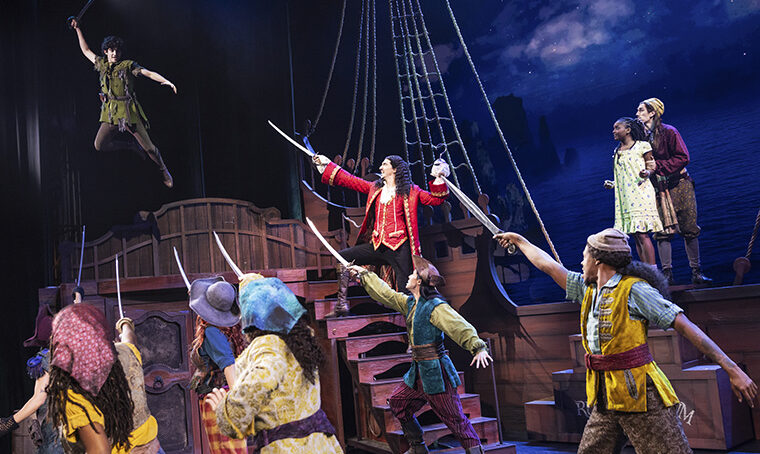

PHOTO BY MATTHEW MURPHY
The titular character comes flying in for the rescue in a new non-equity national touring production of Peter Pan.
By AARON KRAUSE
Before intermission of a new production of Peter Pan, the titular character and Tiger Lily, among others, run together toward the audience and enthusiastically thrust their arms into the air in unison. Certainly, it’s a refreshing, uplifting sight; a display of unity, friendship, and inclusivity that was absent from previous productions of the beloved, classic tale.
In fact, the sequence, which comes during the upbeat and invigorating new number, “Friends Forever,” makes you want to say “Good Riddance” to the nonsensical, stereotype-promoting song, “Ugg-a-Wugg.” Fortunately, that offending number is absent from this new vivacious, inclusive, and believable modern production.
This national, non-equity touring production is playing Miami’s Adrienne Arsht Center through Sunday, May 12. Then, it moves to Orlando and numerous other cities. So, if you live in South Florida and cannot witness a performance during the Miami engagement, you can experience the show in Orlando (May 14-19). Or, you could wait until the 2024-25 season. That is when this new production will play the Broward Center for the Performing Arts in Ft. Lauderdale (May 6-18, 2025). The production lasts for roughly two hours and 20 minutes, including a 15-minute intermission.
The addition of “Friends Forever,” by composer Adolph Green, with lyrics by his daughter, Amanda Green, is one of many changes that Native American playwright Larissa FastHorse and director Lonny Price have made to the show’s libretto and score. The changes strengthen the show’s female characters and rid the piece of Native American and female stereotypes. Another change involves making the cast more diverse, mirroring the diversity of 2024 America. Speaking of the United States, this production takes place in modern day USA, as opposed to past productions’ setting of Victorian England. In addition, expect to hear modern references and see visual delights.
Also, for this production, FastHorse expanded the concept of “Native” in Neverland to include several members of under-pressure Indigenous cultures from all over the world. Specifically, the refugees have retreated to Neverland to preserve their culture until they can find a way back to their homeland. So, in addition to keeping people young forever, Neverland keeps these cultures from dying. Undoubtedly, it’s yet another reason to love this magical place.
While this new production features many changes, fear not folks; this is still the same enchanting, moving, energetic, and tuneful Peter Pan that you, your grandparents, and others have witnessed and grown to love. For instance, the musical still features beloved, recognizable songs. They include “I Gotta Crow,” “I Won’t Grow Up,” “I’m Flying,” and “Neverland.” And the story remains the same, while the beloved, familiar characters are all present. Also, of course, Peter and the Darling children fly.
In addition to the familiar musical numbers, and “Friends Forever,” this new production includes a song titled “When I Went Home.” If you don’t recognize it, that is because Broadway star Mary Martin, who played the title character at the time, requested that the song be cut before the show’s premiere in 1954. Reportedly, Martin thought the song was too sad. But Price reinstated the number, arguing that it is a moving song, which it is.
In fact, “When I Went Home” allows us to experience a vulnerability to Peter we may have missed during previous productions. Such a quality helps to, for instance, balance the boy’s boastfulness with a more endearing quality.
During “When I Went Home,” we learn why Peter refuses to join the Lost Boys when they decide to return to the Darling home with youngsters Wendy, John, and Michael. It’s because the boy who vows never to grow up had an upsetting experience when he tried to return to his childhood home. Consider the simple and heartfelt lyrics to this haunting song.
When I went home
I thought that certainly
Someone would leave the door or window open
wide for me.
And surely there would be a welcome light
When I went home
I counted so upon
Somebody waiting up to ask me questions on and on
To ask me where I’d come
Was I alright?
But the door was barred and the window barred
And I knew with an awful dread
That somebody else, some other boy was sleeping in my bed
When I went home
I found that sad to say
You must expect to be forgotten once you’ve gone away
And so I couldn’t stay that lonely night when I went home
To his credit, Nolan Almeida, who portrays the titular character, humanizes him by singing the song with sadness and sensitivity so that we feel for the lad.
Almeida is a 17-year-old boy. Casting him marks a change from the previous practice of tapping a female adult actor to play the boy who refuses to grow up. Indeed, stars such as Mary Martin, Sandy Duncan, and Cathy Rigby have winningly portrayed the title character. However, casting a boy in the title role lends an even greater authenticity to the part. After all, Peter is a lad.
Almeida shines as the title character, although at times it is difficult to understand him. Indeed, the young actor, with dark hair and dark eyes, imbues the boy with convincing charisma, determination, joyfulness, pride, bravado, nimbleness, and an adventurous quality, in addition to the aforementioned vulnerability.
When Peter flies, Almeida and other actors who take flight look as natural and comfortable airborne as other boys appear when they’re playing sports, talking to their friends, or playing video games. And while we can see the ropes holding Peter and the Darling children when they fly, it’s easy to suspend our disbelief thanks to this production’s vitality. On a related note, David Bengali’s picturesque and seemingly authentic projections make us feel as though we are flying with the characters. Objects seem to pass us by and the stage seems to be in motion.
Meanwhile, on the ground and opposite Almeida, Cody Garcia lends Captain Hook a commanding aura and menace. But the actor, with long, dark hair, dark eyes, and flashing a cunning smile, also endows Hook with a flamboyance. This quality helps to ensure that Hook comes across as not only mean and fearsome, but comical, and somehow lovable. Garcia’s Captain Hook basks in the limelight during “Hook’s Waltz,” the familiar song that celebrates the villain.
One of the production’s weaknesses is that tension between the titular character and Hook could be more palpable.
On the other hand, Strong chemistry exists between Almeida and Raye Zaragoza, as Tiger Lily. Zaragoza portrays a character who seems more assertive, independent, and stronger than past Tiger Lillies. This is partly thanks to Zaragoza’s talent, but we also have FastHorse to thank for strengthening Tiger Lily’s character.
FastHorse, the first known female Native American playwright to have a play produced on Broadway (The Thanksgiving Play) has given Tiger Lily a greater part in the show. Previously, she was largely silent and didn’t help Peter defeat Hook. Now, Tiger Lily is a leader of the tribe and helps Peter take down the villain. Further, Tiger Lily and Wendy (Hawa Kamara) are no longer rivals. Instead, they bond in criticizing Peter for constantly bragging and crowing. In addition, the two female characters create a “Girl Power” tag team while fighting the pirates. “You go girls!” you want to shout.
Speaking of Kamara, her Wendy is at first a dreamy character with girlish excitement. But she matures. And by the time she is a mother figure to the Lost Boys, Kamara’s Wendy seems like a devoted, nurturing parent.
While Peter Pan includes enough material to interest children, it’s also a tale that adults can appreciate. Certainly, the story makes us consider the advantages and disadvantages of remaining young as well as the pros and cons of growing up. Peter Pan also includes relevant themes such as the power of stories and the importance of parents and parental figures in children’s lives.
Under Price’s sensitive direction, the production lends equal weight to elements of the story that will delight children and the more mature content.
Young and older audience members during opening night in Miami seemed attentive and captivated by the action. Some people wore pirate costumes. At least one boy in the audience audibly laughed at a humorous line in the play (this production is funny as well as moving). Chances are, for example, Kurt Perry will make you laugh at his spastic Smee, Captain Hook’s assistant.
As has been the case in previous productions of Peter Pan, adult and child actors share the stage. On opening night, Micha Turner Lee portrayed Michael Darling, lending him courage, as well as a curious, adventure-loving quality, and precocious nature.
Camden Kwok was adorable as younger Darling sibling Michael. Lee and William Foon alternate in the role of John, while Kwok alternates with Reed Epley in the role of Michael.
As the Darling children’s parents, Shefali Deshpande plays Mrs. Darling with a mother’s affection and tenderness, while Garcia, who doubles as Mr. Darling, convincingly imbues the children’s father with impatience.
Musically, the actors possess mostly expressive and strong singing voices. Accompanying them is a vibrant, rich-sounding live orchestra. And the triple-threat performers execute choreographer Lorin Latarro’s physical dances with seeming ease.
Behind the scenes, set designer Anna Louizos nicely contrasts realistic environments with nonrealistic settings. Her Neverland sports a green hue and, with its climbable structures, reinforces a sense of adventure and youthfulness. In addition, Louizos’s detailed depiction of the Darling household features a modern and whimsical look. There’s also a storybook quality to the swashbuckling pirate ship.
The actors wear Sarafina Bush’s character-defining and colorful costumes, which lend the characters individuality and authenticity. Also, behind the scenes, Amith Chandrashaker’s varied lighting neatly contrasts realism from nonrealism. And sound designer Kai Harada’s work helps us hear and understand the actors and includes realistic-sounding effects.
While it might be a cliché, Peter Pan brings out the child in all of us. Of course, the show delights children, but Price has another reason for signing on to direct Peter Pan.
“This is the first show many children are going to see,” he has said. “I don’t only want them to fall in love with Peter Pan. I want them to fall in love with the theater.”
For those of us who care about live theater and its future, such words are, no doubt, music to our ears.
IF YOU GO
WHAT: “Peter Pan.”
WHEN: Remaining performances in Miami are 8 p.m. Friday and Saturday, as well as 2 p.m. Saturday and 1 p.m. and 7 p.m. Sunday. For information about future tour stops, go to www.peterpanontour.com.
WHERE: Adrienne Arsht Center, 1300 Biscayne Blvd. in downtown Miami.
TICKETS: Call (305) 949-6722 or go to www.arshtcenter.org.

